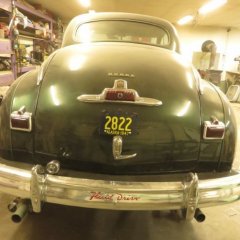Leaderboard
Popular Content
Showing content with the highest reputation on 02/22/2020 in all areas
-
Finally got a chance to see up-close my first Airflow. Wow. What a car. Spectacular. Any other sightings for me were ibn a museum. In a museum I could not get in and check every thing out. That was not the case here. I was over, under, and in this one! Apologies for blocking stuff out here. Just trying to be respectful and show the cars only here.4 points
-
This week I took a few days off work. I got a free pass from my wife and I off I went, alone. I set up a little tour around my region. I visited some really good people who are true Mopar lovers. The Mopar community has been extremely good to me. I keep meeting very nice, welcoming, knowledgable, helpful people. I was welcomed into private garages at several locations. Some garages were brimming with old cars and trucks that we all love. Some people I met people in person for the first time; before only knowing them by their internet forum monikers. I had a fantastic week. I felt spoiled and enamoured with all that I saw. Car rides were had. Some others I even got to drive. I leaned over a few fenders with some friends and turned a few wrenches too. I made some great connections and new friendships. I will share some photos and a few details. However to maintain respect for privacy I will keep the info anonymous. I'll upload several photos, but it could take a few posts. So hang in there, and check back. Here I a 1955 coral pink Desoto. Sportsman trimmed. An orange, (I think 1951?) orange Fargo truck. The V8 equipped hemi, Desoto appeared all stock and so far, mostly untouched. The orange Dodge, extremely clean and still in stages of restoration.3 points
-
Had a wonderful drive in this very nice mid-30's Plymouth. It seemed to run as if it was new. No problem keeping up with traffic. A great heater that was welcomed.2 points
-
The 1937 proving itself. It ran quite well. It seems like the 31,000 miles on the odometer could be accurate. It felt like it when I drove it. It has the 201 engine, which ran extremely smooth and balanced. The clutch, tranny, driveshaft and diff felt tight like new.2 points
-
Here we trouble-shot for a throttle dead spot. We diagnosed a fuel accelerator pump problem and found a tired, shortened spring. Once repaired, a nice country back road tour followed. A 1937 Plymouth Coupe.2 points
-
A fellow club member, now unfortunately dead, had a 1937 Chrysler Airflow with the straight 8 engine. I rode in it several times and got to drive it once. A truly splendid car! I think style-wise they were ahead of their time and so did not sell well. I would have loved to buy the Airflow from his estate but restored Airflows are out of most people's price range, certainly mine.1 point
-
Crate motor should have a warranty that covers oil leaks from factory installed seals. IMO, you don't have an oil problem, you have a seal problem. The seal conditioners sometimes work on older seals that have hardened. Most of them have some ingredient that attacks rubber and softens it. Probably would do the same to a new, soft seal. Just not sure what the results are. Back in the day, brake fluid was the 'seal fix' of choice of some mechanics.1 point
-
That is a car where putting in 5 dollars of gas doubles it’s value1 point
-
: Almost stock flattie. Manifold and block ports gasket matched and ports cleaned up a bit. Head milled a bunch, then the chamber modified around the valve and spark plug area. Wound up at about 8.9: 1 ratio. Stock intake modified to accept a small two barrel Carter BB2 originally on a 273 V8.1 point
-
Sounds like you had a great time; I'm very happy for you! Thanks for sharing. I hope to someday see an Airflow close up. After reading your comments about the trucks I better cherish my B1D a little more!?1 point
-
I believe the issue is related to the ammeter. I disconnected a wire from the starter solenoid. It was one of 2 wires on that particular post. This stopped the drain. At this point I did not know if the car would crank. It did, and all functions including ignition, lights, heater fan, etc. still work. Except for the ammeter. I now have the alternator wire hooked to the negative battery terminal. It is a terminal with multiple connection points so I was able to use a higher gauge wire than what was there. Would this cause any issues long-term? I can't imagine that it would. I will just remove the VR and throw it in the spare parts bin. I have a feeling a previous owner connected the ammeter separate from the regular harness at some point. Later on, I plan to replace every wire on this thing with new cloth-covered wire, but this lets me drive for now.1 point
-
These trucks tug at my heart strings. I hope to have one someday. Another Fargo seen here. Originally only sold in Canada if I recall. Perhaps if I were to set out and find an old Mopar truck to acquire, it might as well be a Fargo.1 point
-
1 point
-
I think this one was a 1930 or so , if I recall. Chrysler. Pretty much original.1 point
-
I've finally got all of the bits and pieces together or arriving shortly to assemble the Cherokee axle. Since it's somewhat of an odd ball aluminum housing Dana 44 I've had to send a few pieces back. The axles arrive tomorrow and I'm really hoping they are the right ones. Their listed dimensions match my original axles so maybe I'll get lucky! So now it's down to painting the axle housing. I spent this afternoon moving the original axle off my Truckster and it's now sitting on a trailer. I'm not really sure what to do with it. I suppose I can list it in the classifieds, maybe someone can use it. While shuffling things around I made a quick and dirty A-frame stand to suspend the axle housing in the air so I can paint it. It's not the prettiest thing I've thrown together but it was 25 degrees out while I was building it so I don't feel to bad With luck I'll have the housing at least primered this weekend with final coat to follow later in the week. Brad1 point
-
One final swap, maybe not too unusual. I used to own an 87 Diplomat I bought from the Travis County sheriff, old detective car. I swapped out the 318/auto for a warmed up 360 and a 4 speed. The 318 made it's way into my 65 Cuda, replacing the tired 273 that was in it.1 point
-
Noah, Never be afraid to drive your car! They are meant to be driven and enjoyed. Penetrol is unlike linseed oil. It dries VERY quickly, and once it's dry nothing will stick to it. You can use a cloth to wipe off dust fast and easy. I applied the penetrol to my car with a foam paint brush. I don't believe you could apply it with a rag in circular motions because it is very thin like water. Although my finish is quite worn compared to when I applied it, my car has been through a lot of weather since then. And for the $8 it cost me to brush it on, it was well worth it. Glad you like my thread. I really try to encourage everyone to drive their cars. After all, what are you saving it for? Drive it and love it! I will check out your posts. Penetrol should be dry in as little as an hour or two. But one could leave it overnight just to be safe.1 point
-
Thanks! I am definitely I am anxious to hear more information on Wordens process with penetrol. I will definitely share more picture when I have some time. These cars deserve to be driven. Reading these post have made me realize that more often than not.1 point
-
Yes, let's revisit the alternator hook up, I thought we went through this earlier but now I'm wondering about it. The old, external regulator, if still in place, should ONLY be used as a terminal block to connect the wire from the alternator to the car's wire that goes to the ammeter. Disconnect everything from the A and F terminals on the regulator. Tell you what I would do (and did on my car)......remove the old regulator and toss in on the work bench (or trash). Then use a high-quality butt splice to connect the alternator lead and ammeter wire (the one that was connected to the BAT terminal of the old regulator). There MIGHT be a faulty internal drain to ground in the old regulator, removing it eliminates that possibility. One more test. With the ammeter lead disconnected from the alternator and the ignition switch off, check to see if there is any continuity between the ammeter wire and chassis ground. This will explore the possibility of a ground drain occurring in the harness or ignition switch (or headlight switch?). If your car passes that test and the alternator is connected to the ammeter, your alternator is good, the battery is good........this system has to work properly.1 point
-
As long as goats just carried rifles most likely more people would go. Free rifle, rug and meat for the table. lol1 point
-
Not all at once. I did swap a coil in a couple of minutes, 5 minutes to swap carbs, changed a tire in 3 minutes (use antiseize on lugbolts to make this possible) LOL I leave 10 minutes early for work just in case.1 point
-
One of the quickest ways to get a quick health check on your electrical system is watch your ammeter! It will tell you all kinds of valuable information if you know how to read it! Most modern cars now use a voltmeter to provide limited information about your electrical system. Or even worse just a warning light to let you know your alternator has failed. Because voltmeters are now the norm the skill of interpreting the information the ammeter provides is becoming a lost art. Let’s walk through a driving sequence to understand what the ammeter will reveal about your electrical system. Entering the car your the ammeter should be reading "0", straight up. You may see a quick defection to the minus side if your have an interior light that comes on with opening the door. It's at "0" because you are not using any or generating any current (engine is not running). When you turn on the ignition you will see the needle move slightly to the minus (discharge) side indicating a discharge of a couple amps. This means your ignition system is getting power. When you hit the starter the ammeter will deflect sharply to the left (minus 20-30 amps) as the starter spins. The energy for the starter is being drawn straight from the battery. As the engine fires the ammeter will quickly move to the plus side (charging) of the gauge in the 20-30 amp range. The energy that was drawn down from the battery while starting is quickly being replaced by charging current from the generator. As you start driving the voltage regulator will manage the amount of charge needed to go back into the battery. After around five minutes of driving typically the battery will start to approaches full charge and you will see a reduction of charge rate down to 1-3 amps on the plus side. At this point the battery has fully recovered from the starter discharge and now the generator is putting out only enough current to maintain the charge. The voltage regulator manages the on-going charge rate. While your driving night time is coming and it is getting cooler. You turn on your headlights and start up the heater fan. Immediately you see the needle momentarily jump to the minus side, then come back to 1-3 amps on the charge side as the regulator manages the generator output to meet the increased demand. As you come to a stop sign and the engine speed drops, the ammeter will move sharply to the minus side, often 15-20 amps down. You notice the lights dim and the heater motor may slow. Right now your generator is not creating enough power to offset the increased load of the headlight and heater motor and is drawing backup power from the battery. This lack of sufficient power generation can fully discharge a battery if allowed to go for a long period. The short stop at the stoplight however, is not harmful. In fact, you can always bump the manual throttle to bring the idle up enough to stop the discharge. As soon as you accelerate from the stop the generator will again start generating sufficient current to replenish the energy pulled from the battery (expect a jump to 5-10 amps charge for a short period) before settling back to a trickle charge of a couple amps while driving. So how can you use if for some basic troubleshooting? When you first get in and step on the break pedal, the ammeter should deflect slightly to discharge as the brake lamp lights. This lets you know the battery has some charge. No deflection? Battery is probably dead or disconnected. Also when you turn on the key if you don't see a slight discharge indication your ignition is probably not connected or functional. If when turning on the key and immediate your have a full discharge (minus 35 amps) you have a dead short that needs to be repaired. Immediately turn off the key and begin trouble shooting to find the electrical short. Otherwise you risk the very real danger of a wiring fire. Might start your troubleshooting at the headlight switch as they have historically been trouble spots due to corrosion resistance in the connectors. If you are running and suddenly see a continuous discharge usually this indicates a voltage regulator issue. Try tapping the regulator case with a screwdriver handle to see if a relay is sticking and it starts charging again. On teh other hand if you see a continuous rate of high charge (> 20 amps) that never goes down you may have a battery starting to fail (it's not taking or holding a charge) or a voltage regulator failing. Either way it's time to troubleshoot the generator and regulator charging circuit. By watching the action of your ammeter your can easily tell if your electrical system is functioning correctly. It will tell you if you have a short, your battery is full charged, how fast it is charging and how much current your are consuming while driving. Compared to a voltmeter which simply gives system voltage, ammeters allow you active monitor your electrical system. Share what on the road lessons have you learned by paying attention to your ammeter!1 point








